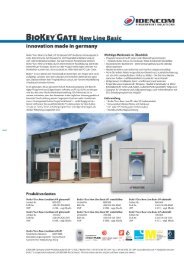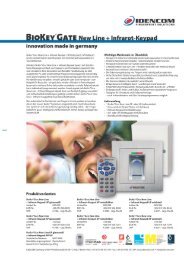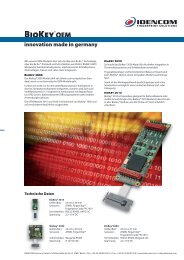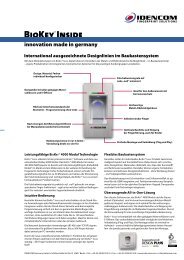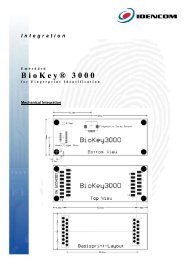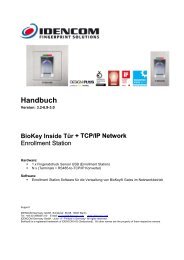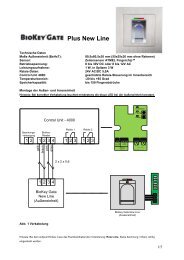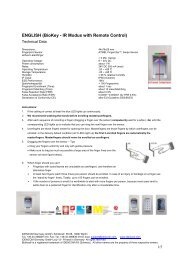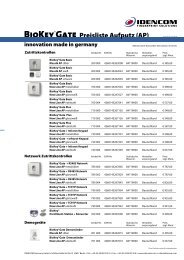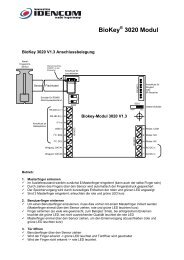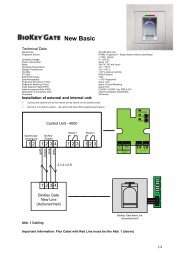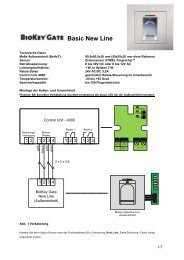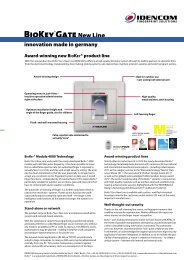Wiegand Interface Description - Idencom
Wiegand Interface Description - Idencom
Wiegand Interface Description - Idencom
You also want an ePaper? Increase the reach of your titles
YUMPU automatically turns print PDFs into web optimized ePapers that Google loves.
B i o K e y ®<br />
W i e g a n d I n t e r f a c e 2<br />
D e f i n i t i o n
1. Common Information<br />
For the BioKey® communication, only three out of five wires of the <strong>Wiegand</strong>-26 interface are<br />
used; these are Data1, Data0 and Ground.<br />
Signal levels are CMOS-compliant (3.3V and 0V). Maximum current is 8 mA per signal line.<br />
Signals are inverted respective to the logic levels defined in the <strong>Wiegand</strong> specification. This is<br />
because the BioKey® 3000 module does not deliver the signals with an open collector output.<br />
To realize the open collector feature, a transistor has to be connected to the module’s<br />
<strong>Wiegand</strong> outputs. This will automatically invert the signals.<br />
2. Data Pulses and Timing<br />
3. Protocol<br />
The Data1 and Data0 signals are normally held at 0V. When data is transmitted,<br />
asynchronous high pulses are placed on the appropiate data line. For proper <strong>Wiegand</strong><br />
function, the signals have to be inverted (see above).<br />
______ ______<br />
/ \ / \<br />
DataX ___/ \ ____________________/ \ ______________<br />
| tpw | tpi | tpw |<br />
Pulse width time tpw is 100µs, pulse interval time tpi is 1ms.<br />
Data is transmitted according to the standard 26-bit <strong>Wiegand</strong> format H10301. It is binary<br />
encoded data, consisting of 1 bit even parity, 8 bit facility code, 16 bit card number and 1 bit<br />
odd parity. Data is transmitted most significant bit and byte first.<br />
To meet the requirements of an embedded fingerprint solution, <strong>Idencom</strong> has altered the<br />
meaning of the 3 data bytes. The bytes will carry the lowest 16 bits of the recognized finger’s<br />
person-id (PID) and the 8 bits of the finger-id (FID).<br />
The <strong>Wiegand</strong> telegram is transmitted once after each identification of a finger, but not if the<br />
process was triggered by the IDENCOM telegram 0x21 (Identification). However, if a <strong>Wiegand</strong><br />
telegram is also needed when the identification is to be triggered by a controller device via an<br />
IDENCOM telegram, command 0x23 (Identification with signaling) can be used.<br />
The <strong>Wiegand</strong> telegram transmission can be disabled using command 0x02 (see protocol<br />
document). Command 0x23 will still work even if <strong>Wiegand</strong> is disabled.<br />
If the identification was successful, the PID bytes contain the PID of the identified person.<br />
And the FID byte contains the FID of the identified finger. Otherwise the PID bytes are set to<br />
0xFFFF and the FID to 0xFF for logging purposes. This leads to a valid PID range from 0 to<br />
65535.<br />
<strong>Wiegand</strong> telegram structure:<br />
even PID (bits 15 .. 8) PID (bits 7 .. 0) FID (bits 7 .. 0) odd<br />
2



